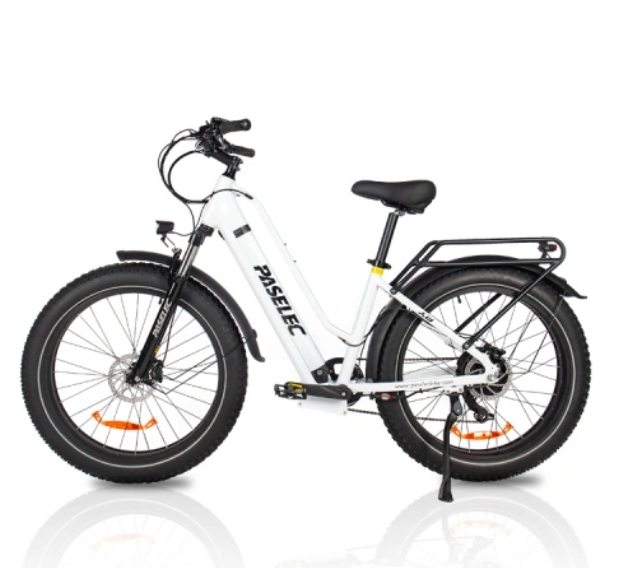
Privacy statement: Your privacy is very important to Us. Our company promises not to disclose your personal information to any external company with out your explicit permission.
News
Home > Company News > The appearance of bicycles is good for society
2024-08-20

First, reduce carbon emissions and air pollution
Zero emissions: The bicycle does not produce exhaust emissions during driving, so there is no release of carbon dioxide and other harmful gases, effectively reducing greenhouse gas emissions and air pollution.
Improving air quality: With the increase in the number of cars in cities, exhaust emissions have become one of the main sources of air pollution. The widespread use of bicycles can significantly reduce this pollution, improve the air quality of cities and protect the health of residents.
Second, save energy
No fuel: The bike does not need fuel or electricity to drive it, and relies entirely on human riding, so it does not consume any energy during use. This will help reduce dependence on non-renewable energy sources such as oil and gas and promote energy conservation and sustainable use.
Ease energy pressure: In the context of global energy tension, the popularity of bicycles helps to ease the pressure on energy supply and contribute to the sustainable development of society.
Third, promote green travel
Alternative to short trips: Bicycles are great for short trips, such as commuting, shopping, leisure, etc. By choosing to travel by bicycle, people can reduce their dependence on cars, thus reducing traffic congestion and air pollution.
Promote public awareness of environmental protection: The widespread use of bicycles can guide the public to pay attention to environmental protection issues, enhance environmental awareness, and promote more people to choose green travel methods.
Enhance physical fitness and exercise muscles
Whole body exercise: Cycling is a whole body exercise that can exercise the muscles of the legs, hips, back, waist and arms. This holistic approach helps build overall strength in the body.
Strengthen heart and lung function: Cycling is an aerobic exercise that can increase heart rate and breathing and improve heart and lung function. Long-term cycling strengthens the heart muscle, improves the efficiency of the blood circulation system, and helps reduce blood pressure and the risk of heart disease.
Prevention of disease and maintenance of health
Prevention of osteoporosis: When cycling, the muscles of the legs and hips are exercised, which creates stress on the bones, helping to increase bone density and prevent osteoporosis. This is especially important for middle-aged and older adults to maintain bone health and strength.
Reduce the risk of cardiovascular disease: Regular cycling can lower cholesterol levels, improve the proportion of blood lipids, and help prevent atherosclerosis and cardiovascular disease. Studies have shown that long-term cyclists have a significantly reduced risk of cardiovascular disease.
Mental health and mood improvement
Release stress and relieve mood: Riding a bike can temporarily put aside the troubles of work and life, and enjoy the time alone. This kind of exercise can help release stress, relieve mood, and improve mental health.
Improve self-confidence and happiness: People who cycle regularly are more likely to feel happy and satisfied, and improve self-confidence and happiness. This positive emotional state contributes to a better quality of life.
Improve body coordination and balance
Improve physical coordination: Cycling needs to master balance and coordination, which is a good exercise for the coordination of the body. Long-term cycling helps improve coordination and stability, reducing the risk of accidental falls.
Exercise neuromuscular coordination: bicycle exercise is a nerve innervation movement, the legs alternate regular force, can effectively stimulate the left and right brain, exercise neuromuscular coordination, prevention of neurodegenerative diseases such as Alzheimer's disease is beneficial.

Reduce road congestion: With the acceleration of urbanization and the proliferation of cars, traffic congestion has become a serious problem for many cities. As a non-motor vehicle, bicycles do not occupy motor vehicle lanes and can effectively reduce road congestion. During short trips or peak traffic hours, choosing a bicycle as a travel mode can avoid congested sections and improve travel efficiency.
Reduce traffic emissions: Vehicle emissions are one of the main sources of urban air pollution, posing a threat to the environment and human health. As a zero-emission means of transportation, the use of bicycles can significantly reduce carbon emissions in the transportation sector, contribute to improving air quality and protecting the environment.
Promote public transport connectivity: The organic combination of bicycles and public transport (such as subway and bus) can form a more efficient and convenient travel network. Passengers can utilize bicycles as a "last mile" solution to get to or from public transport stations, thereby increasing the accessibility and attractiveness of public transport and further reducing the use of private cars.
Improve the image of the city: Encouraging bicycle travel not only helps to relieve traffic pressure, but also enhances the green image and cultural connotation of the city. By building infrastructure such as bike lanes and bike rental systems, many cities are creating a livable and tour-friendly urban environment, attracting tourists and investment, and promoting urban economic development.
Direct reduction in transportation costs: Compared to ticketing fees for cars, taxis, or public transport (such as long-distance buses, trains, etc.), the cost of running a bicycle is almost zero (with little extra expense for daily riding except for purchase, maintenance, and possibly equipment costs). For short business trips or daily commutes, choosing a bicycle can significantly reduce the cost of transportation.
Save on parking and gas: When driving a private car for business or travel, it is often necessary to pay expensive parking and gas fees. Bikes, on the other hand, avoid these extra costs by eliminating the need for fuel and searching for parking Spaces. This advantage is particularly evident in places where parking costs are high, such as cities or scenic spots.
Flexibility and convenience: Bicycles have high flexibility and convenience, and can easily shuttle through the city's alleys and traffic jams. This means that when using a bicycle for business travel, you can get to your destination more quickly, reducing the time and expense wasted in traffic jams.
Ease traffic congestion
Improve road traffic efficiency: bicycles occupy small road space and ride flexibly, which can effectively alleviate urban traffic congestion. Especially during peak hours, bicycle travel can divert part of the motor vehicle flow and reduce the pressure on the road.
Improve the slow driving system: Through the construction of bicycle lanes, optimizing the cycling environment and other measures, the slow driving system of the city can be improved, and the travel experience and safety of cyclists can be improved. This will help attract more citizens to choose bicycles and further ease traffic congestion.
Improve the quality of urban life
Beautify the urban environment: The construction of bike lanes can be combined with urban greening and landscape improvement to create a beautiful and comfortable cycling environment. This can not only enhance the overall image of the city, but also provide citizens with a good place for leisure and fitness.
Enhance citizens' happiness: Bicycle travel helps to improve citizens' physical fitness and quality of life. Through cycling, citizens can enjoy the fun and health benefits of sports, thereby enhancing their sense of well-being and fulfillment.
Promote innovation in urban planning
Optimizing urban spatial layout: Fully considering the needs of bicycle travel in urban planning can promote the optimization of urban spatial layout. For example, through the construction of bicycle lanes, increasing bicycle parking facilities and other measures, urban space can be guided to a more compact and efficient direction.
Promote the integration of multi-mode transportation: Bicycle travel can form a complementary relationship with other modes of transportation such as public transportation and walking, and jointly constitute a multi-mode transportation system. Through reasonable planning of the connection relationship between bicycle lanes and public transport stations, the overall operation efficiency and service level of urban traffic can be improved.
Foster community interaction: Cycling as a convenient way to get around for short distances encourages people to get out of the house, explore and participate in community activities. Whether it is daily shopping, commuting, or recreational cycling, bicycles make people more frequent in community Spaces, increasing the opportunity to meet and interact with neighbors. This face-to-face interaction helps build closer relationships and enhances a sense of belonging in the community.
Increased awareness of environmental protection: Bicycles, as a zero-emission means of transport, help reduce air pollution and traffic congestion. When more and more people choose cycling as a way to get around, they are not only thinking about their own health, but also contributing to improving the quality of the environment. This common environmental action can stimulate people's sense of responsibility and mission, promote the concern and cooperation of all sectors of society on environmental issues, and thus enhance the overall cohesion of society.
Cultural inheritance and display: Bicycles, as a means of transportation with a long history, carry rich cultural connotations. In many countries and regions, cycling has become a cultural phenomenon and a tourist project. By organizing cycling activities and holding bicycle culture festivals, the local cultural characteristics, natural scenery and cultural customs can be displayed to attract tourists to experience and exchange. Such cultural exchanges not only promote the development of tourism, but also deepen the understanding and friendship between people from different regions and different cultural backgrounds

Share to:
Send Inquiry

Mr. Leo
Tel:+86-0757-81092607
Fax:+86-0757-81092967
Mobile Phone:8617718868618
Email:hedatx2023@hotmail.com
Address:6/F, No.18 South, Wujia Development Zone, Xilian, Danzao Town, Nanhai District, Foshan, Guangdong
Related Products List
Mobile Site


Privacy statement: Your privacy is very important to Us. Our company promises not to disclose your personal information to any external company with out your explicit permission.

Fill in more information so that we can get in touch with you faster
Privacy statement: Your privacy is very important to Us. Our company promises not to disclose your personal information to any external company with out your explicit permission.